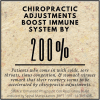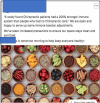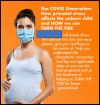Misinformation, chiropractic, and the COVID-19 pandemic
- PMID: 33208144
- PMCID: PMC7672412
- DOI: 10.1186/s12998-020-00353-2
Misinformation, chiropractic, and the COVID-19 pandemic
Abstract
Background: In March 2020, the World Health Organization elevated the coronavirus disease (COVID-19) epidemic to a pandemic and called for urgent and aggressive action worldwide. Public health experts have communicated clear and emphatic strategies to prevent the spread of COVID-19. Hygiene rules and social distancing practices have been implemented by entire populations, including 'stay-at-home' orders in many countries. The long-term health and economic consequences of the COVID-19 pandemic are not yet known.
Main text: During this time of crisis, some chiropractors made claims on social media that chiropractic treatment can prevent or impact COVID-19. The rationale for these claims is that spinal manipulation can impact the nervous system and thus improve immunity. These beliefs often stem from nineteenth-century chiropractic concepts. We are aware of no clinically relevant scientific evidence to support such statements. We explored the internet and social media to collect examples of misinformation from Europe, North America, Australia and New Zealand regarding the impact of chiropractic treatment on immune function. We discuss the potential harm resulting from these claims and explore the role of chiropractors, teaching institutions, accrediting agencies, and legislative bodies.
Conclusions: Members of the chiropractic profession share a collective responsibility to act in the best interests of patients and public health. We hope that all chiropractic stakeholders will view the COVID-19 pandemic as a call to action to eliminate the unethical and potentially dangerous claims made by chiropractors who practise outside the boundaries of scientific evidence.
Keywords: Chiropractors; Covid-19; Debate; Infodemic; Professional traditionalism; Spinal manipulation.
Conflict of interest statement
IA is deputy editor, JH and SP are associate editors and CLY is senior advisory editor on Chiropractic and Manual Therapies. They were not involved in or had any influence over the review process or the decision to publish. None of the remaining authors have any competing interests to declare.
Figures









References
-
- WHO Director-General's opening remarks at the media briefing on COVID-19 - 11 March 2020 [https://www.who.int/dg/speeches/detail/who-director-general-s-opening-re...]. Accessed 17 Apr 2020.
-
- WFC: Coronavirus disease 2019 - Advice for Chiropractors [https://www.wfc.org/website/images/wfc/Latest_News_and_Features/Coronavi...]. Accessed 28 Mar 2020.
Publication types
MeSH terms
Grants and funding
LinkOut - more resources
Full Text Sources
Medical
Miscellaneous

